Chilingarian G.V. et al. Surface Operations in Petroleum Production, II
Подождите немного. Документ загружается.

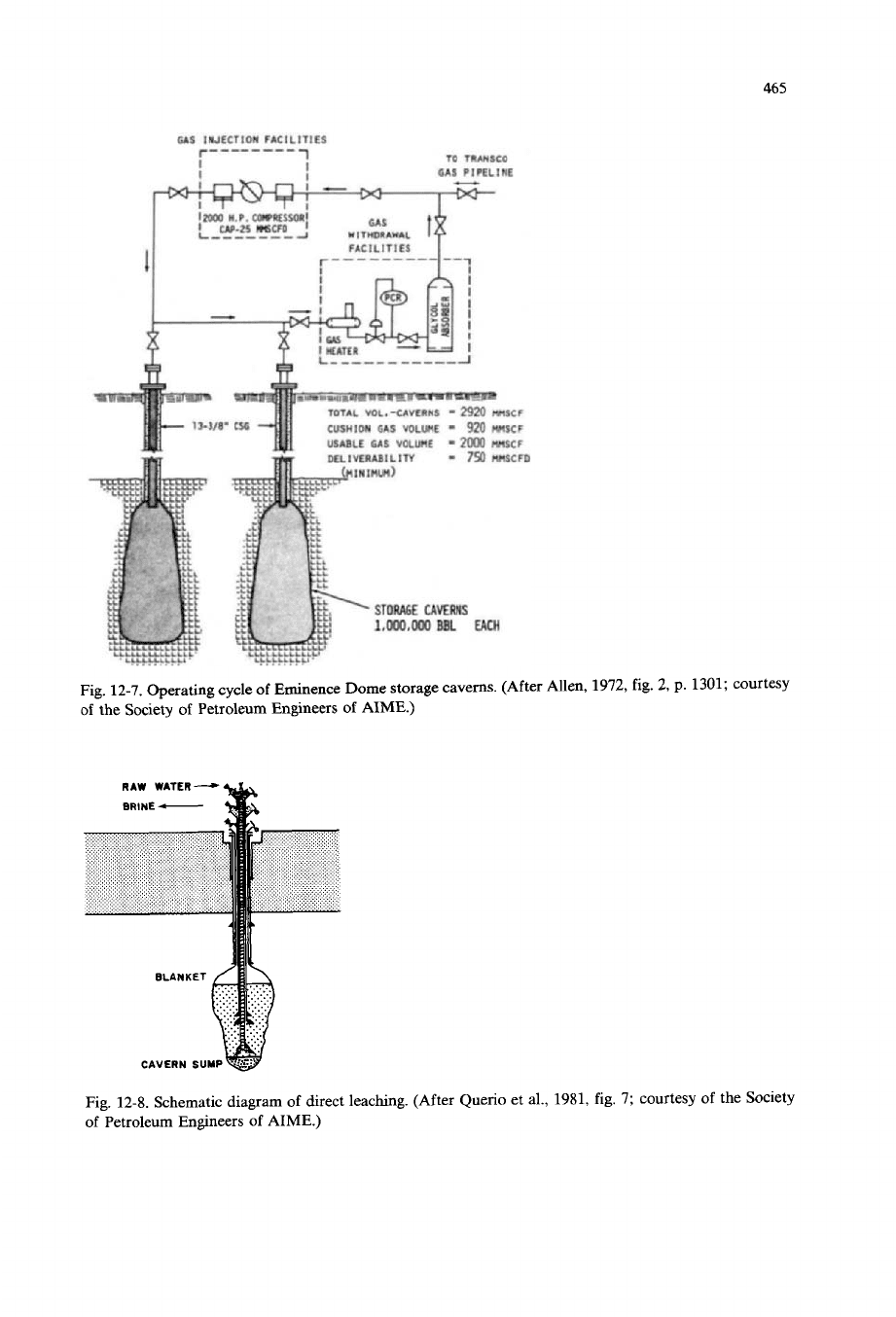
465
Fig. 12-7. Operating cycle
of
Eminence Dome storage caverns. (After Allen, 1972, fig. 2,
p.
1301; courtesy
of
the Society
of
Petroleum Engineers
of
AIME.)
RAW WATER-
BRINE
-
BLANKET?'
.... ._..
52
y
CAVERN
SUMP
Fig. 12-8. Schematic diagram of direct leaching. (After Queno et al., 1981, fig. 7; courtesy
of
the Society
of
Petroleum Engineers
of
AIME.)
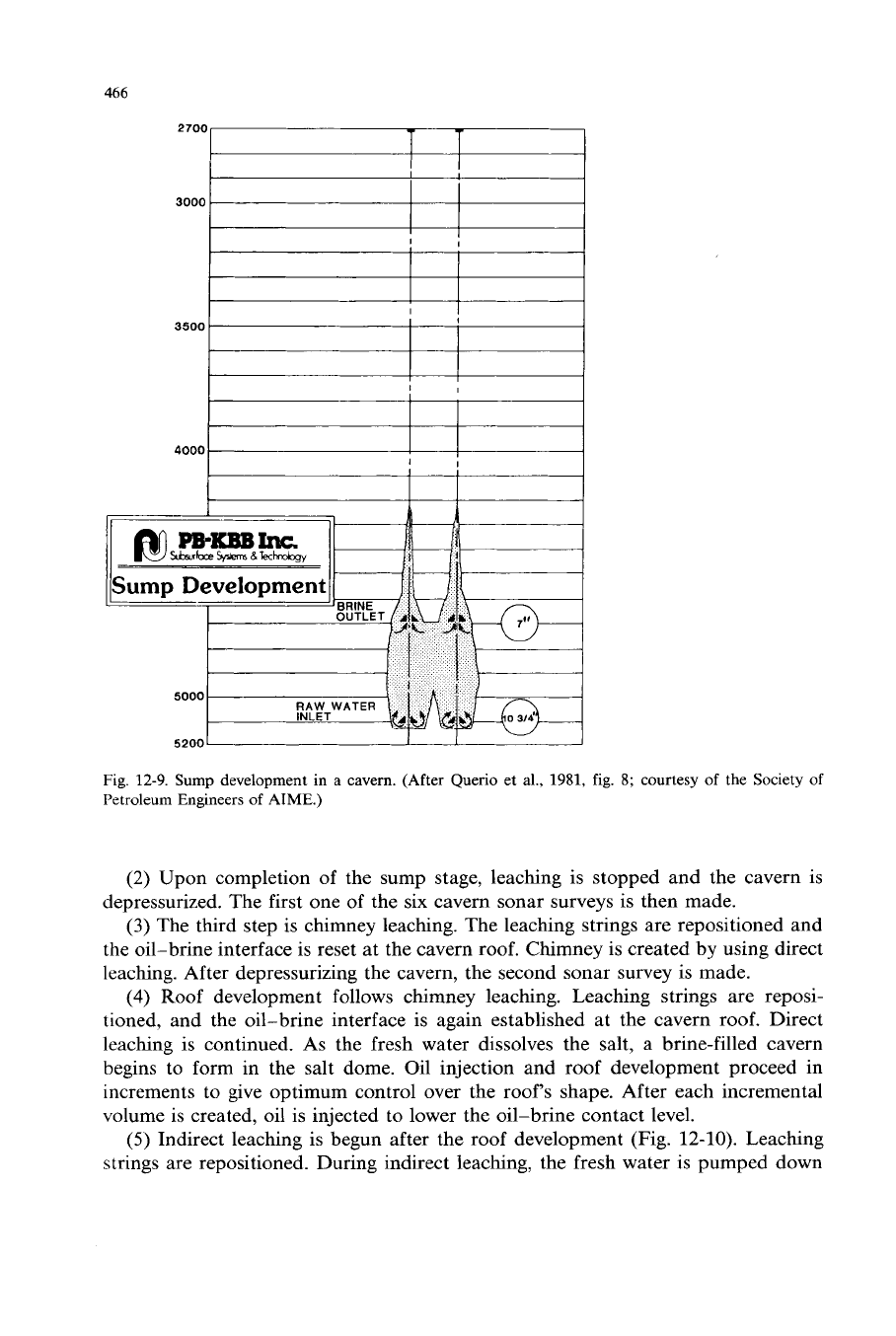
466
2700
T
T
3000c
I
I
I
I
35001
4000
I
i
I
I
Fig. 12-9.
Sump development in
a
cavern. (After Querio et
al.,
1981,
fig. 8; courtesy
of
the Society
of
Petroleum Engineers
of
AIME.)
(2)
Upon completion of the sump stage, leaching is stopped and the cavern is
depressurized. The first one of the six cavern sonar surveys is then made.
(3)
The third step
is
chimney leaching. The leaching strings are repositioned and
the oil-brine interface is reset at the cavern roof. Chimney is created
by
using direct
leaching. After depressurizing the cavern, the second sonar survey is made.
(4)
Roof development follows chimney leaching. Leaching strings are reposi-
tioned, and the oil-brine interface is again established at the cavern roof. Direct
leaching is continued. As the fresh water dissolves the salt, a brine-filled cavern
begins to form in the salt dome. Oil injection and roof development proceed in
increments to give optimum control over the roof's shape. After each incremental
volume is created, oil is injected to lower the oil-brine contact level.
(5)
Indirect leaching is begun after the roof development (Fig.
12-10).
Leachmg
strings are repositioned. During indirect leaching, the fresh water is pumped down
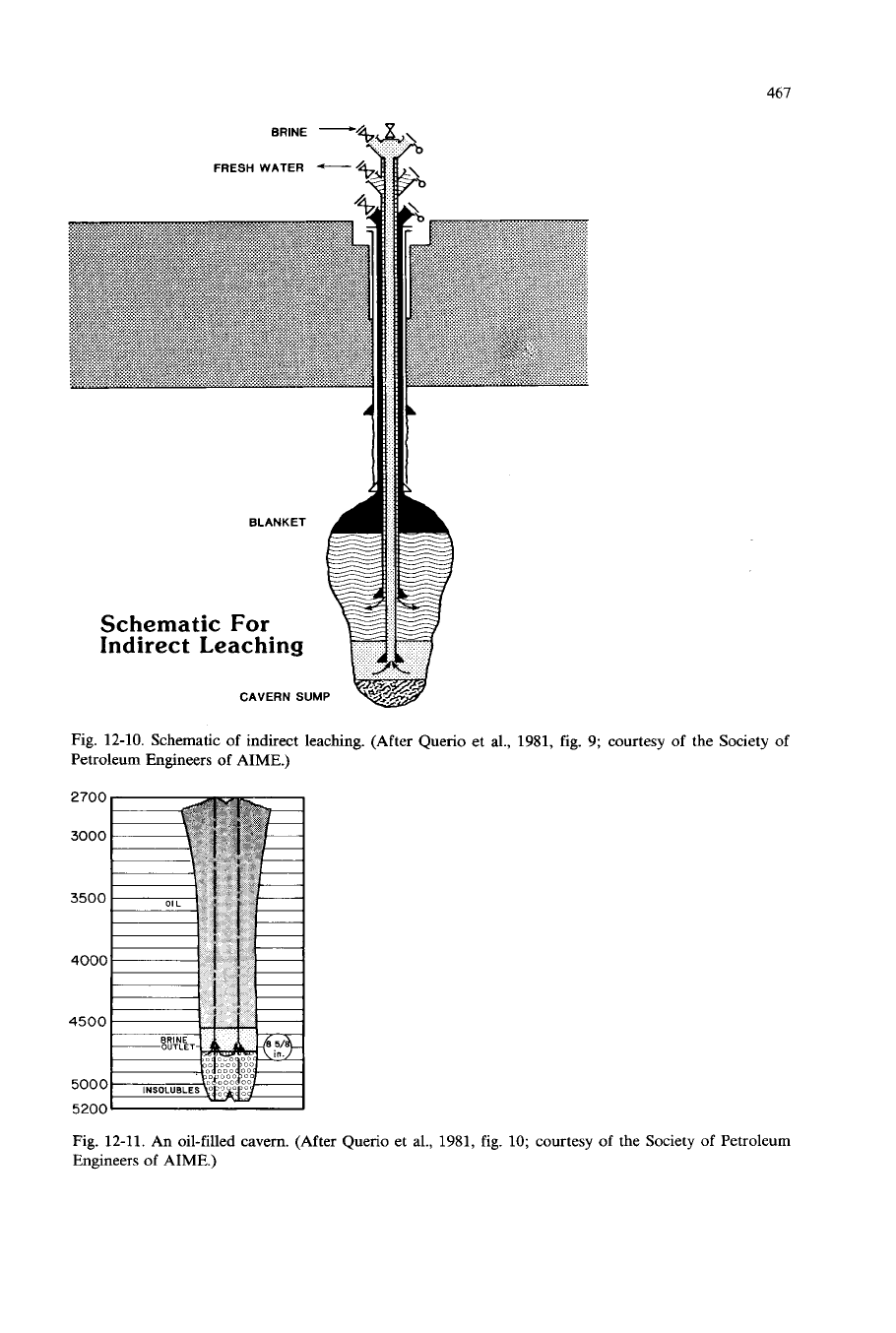
461
BRINE
ZIP
BLANKET
Schematic For
Indirect Leaching
CAVERNSUMP
Fig. 12-10. Schematic
of
indirect leaching. (After Querio et al., 1981, fig. 9; courtesy
of
the Society
of
Petroleum Engineers
of
AIME.)
2700
3000
3500
4000
4500
5000
5200
Fig. 12-11. An oil-filled cavern. (After Querio et al., 1981, fig.
10;
courtesy
of
the Society
of
Petroleum
Engineers
of
AIME.)
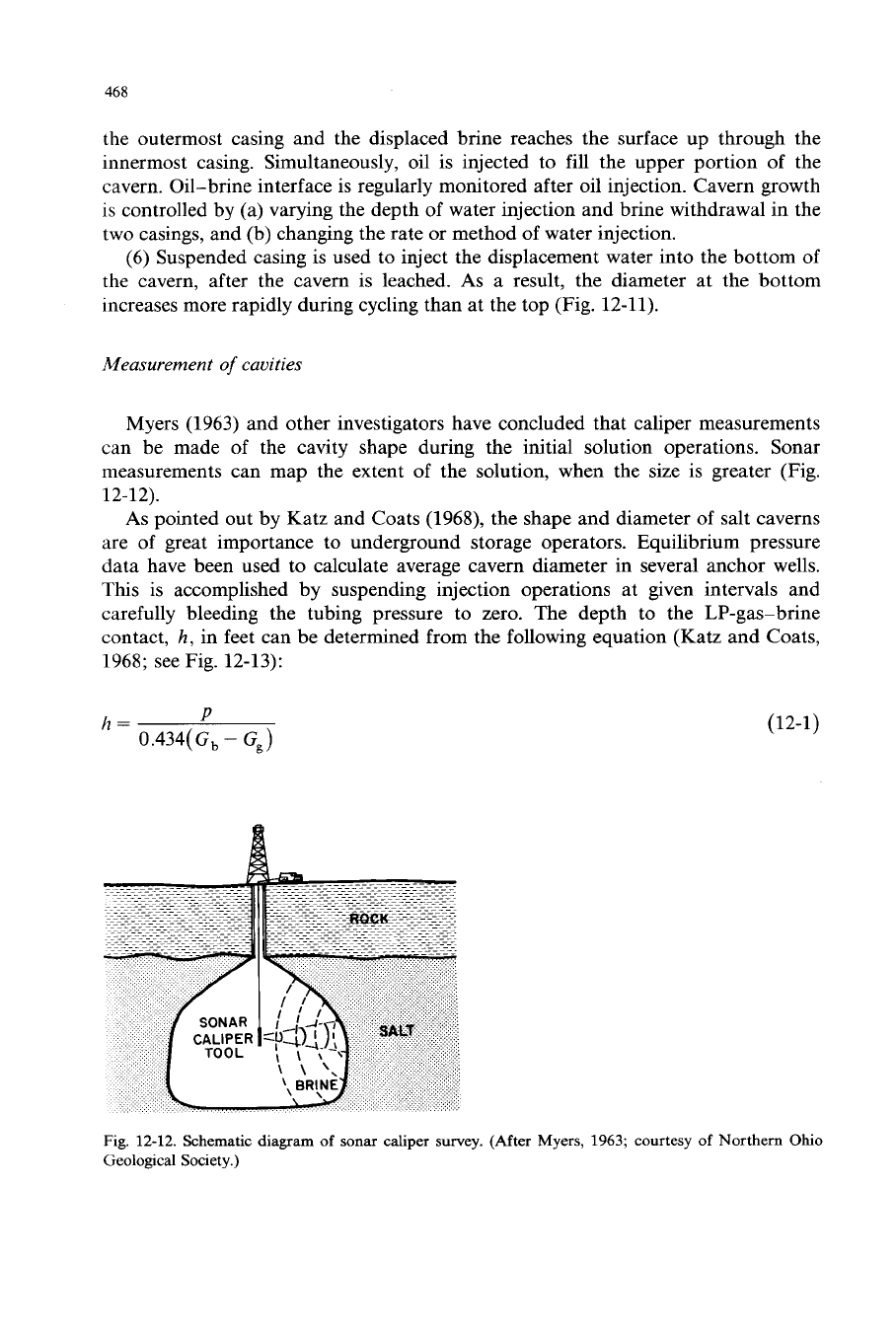
468
the outermost casing and the displaced brine reaches the surface up through the
innermost casing. Simultaneously, oil
is
injected to fill the upper portion of the
cavern. Oil-brine interface is regularly monitored after oil injection. Cavern growth
is
controlled by (a) varying the depth
of
water injection and brine withdrawal in the
two casings, and (b) changing the rate or method
of
water injection.
(6) Suspended casing is used to inject the displacement water into the bottom
of
the cavern, after the cavern is leached.
As
a result, the diameter at the bottom
increases more rapidly during cycling than at the top (Fig. 12-11).
Measurement
of
cavities
Myers (1963) and other investigators have concluded that caliper measurements
can be made of the cavity shape during the initial solution operations. Sonar
measurements can map the extent
of
the solution, when the size is greater (Fig.
12-12).
As
pointed out by Katz and Coats (1968), the shape and diameter
of
salt caverns
are of great importance to underground storage operators. Equilibrium pressure
data have been used to calculate average cavern diameter in several anchor wells.
This
is accomplished by suspending injection operations at given intervals and
carefully bleeding the tubing pressure to zero. The depth to the LP-gas-brine
contact,
h,
in feet can be determined from the following equation (Katz and Coats,
1968; see Fig. 12-13):
P
0.434(
G,
-
Gg)
h=
(12-1)
Fig. 12-12. Schematic diagram
of
sonar
caliper survey. (After Myers,
1963;
courtesy
of
Northern
Ohio
Geological Society.)
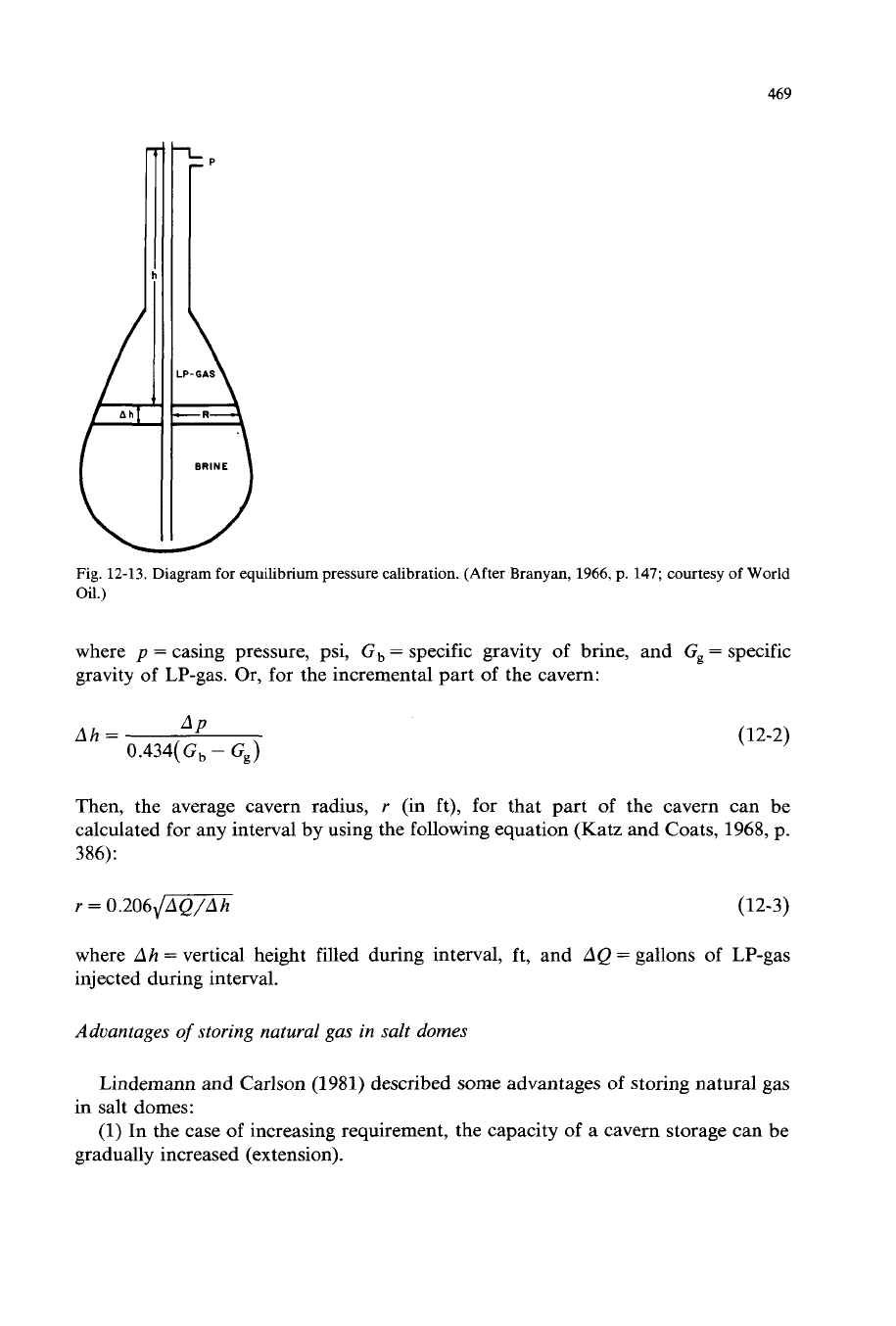
469
Fig. 12-13. Diagram for equilibrium pressure calibration. (After Branyan, 1966,
p. 147;
courtesy
of
World
Oil.)
where
p
=
casing pressure, psi,
G,
=
specific gravity of brine, and
Gg
=
specific
gravity of LP-gas. Or, for the incremental part of the cavern:
AP
Ah
=
0.434(
Gb
-
G,)
(12-2)
Then, the average cavern radius,
r
(in ft), for that part of the cavern can be
calculated for any interval by using the following equation (Katz and Coats, 1968, p.
386):
r
=
0.206,/-
(12-3)
where
Ah
=
vertical height filled during interval, ft, and
AQ
=
gallons of LP-gas
injected during interval.
Advantages
of
storing natural gas
in
salt
domes
Lindemann and Carlson (1981) described some advantages
of
storing natural gas
(1) In the case of increasing requirement, the capacity of
a
cavern storage can be
in
salt domes:
gradually increased (extension).
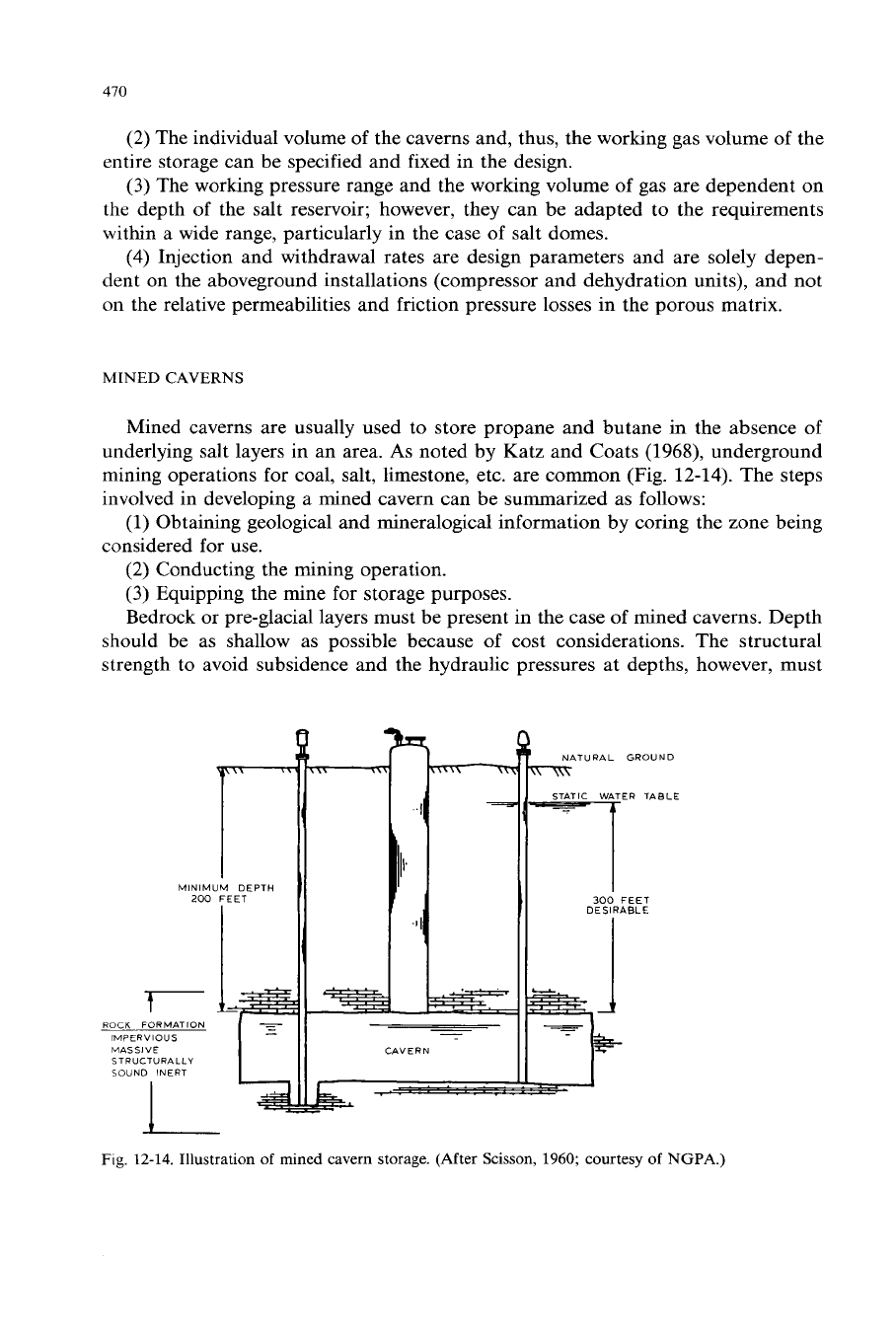
470
(2) The individual volume of the caverns and, thus, the working gas volume of the
entire storage can be specified and fixed in the design.
(3)
The working pressure range and the working volume of gas are dependent on
the depth of the salt reservoir; however, they can be adapted to the requirements
within a wide range, particularly in the case
of
salt domes.
(4) Injection and withdrawal rates are design parameters and are solely depen-
dent
on
the aboveground installations (compressor and dehydration units), and not
on the relative permeabilities and friction pressure losses in the porous matrix.
MINED CAVERNS
Mined caverns are usually used to store propane and butane in the absence of
underlying salt layers in an area.
As
noted by Katz and Coats
(1968),
underground
mining operations for coal, salt, limestone, etc. are common (Fig. 12-14). The steps
involved in developing a mined cavern can be summarized as follows:
(1) Obtaining geological and mineralogical information by coring the zone being
considered for use.
(2) Conducting the mining operation.
(3)
Equipping the mine for storage purposes.
Bedrock or pre-glacial layers must be present in the case of mined caverns. Depth
should be as shallow as possible because
of
cost considerations. The structural
strength to avoid subsidence and the hydraulic pressures at depths, however, must
TURAL GROUND
STATIC WATER TABLE
300
FEET
ROCK FORMATION
IMPERVIOUS
MASSIVE
STRUCTURALLY
SOUND INERT
I
Fig.
12-14.
Illustration
of
mined cavern storage. (After Scisson,
1960;
courtesy
of
NGPA.)
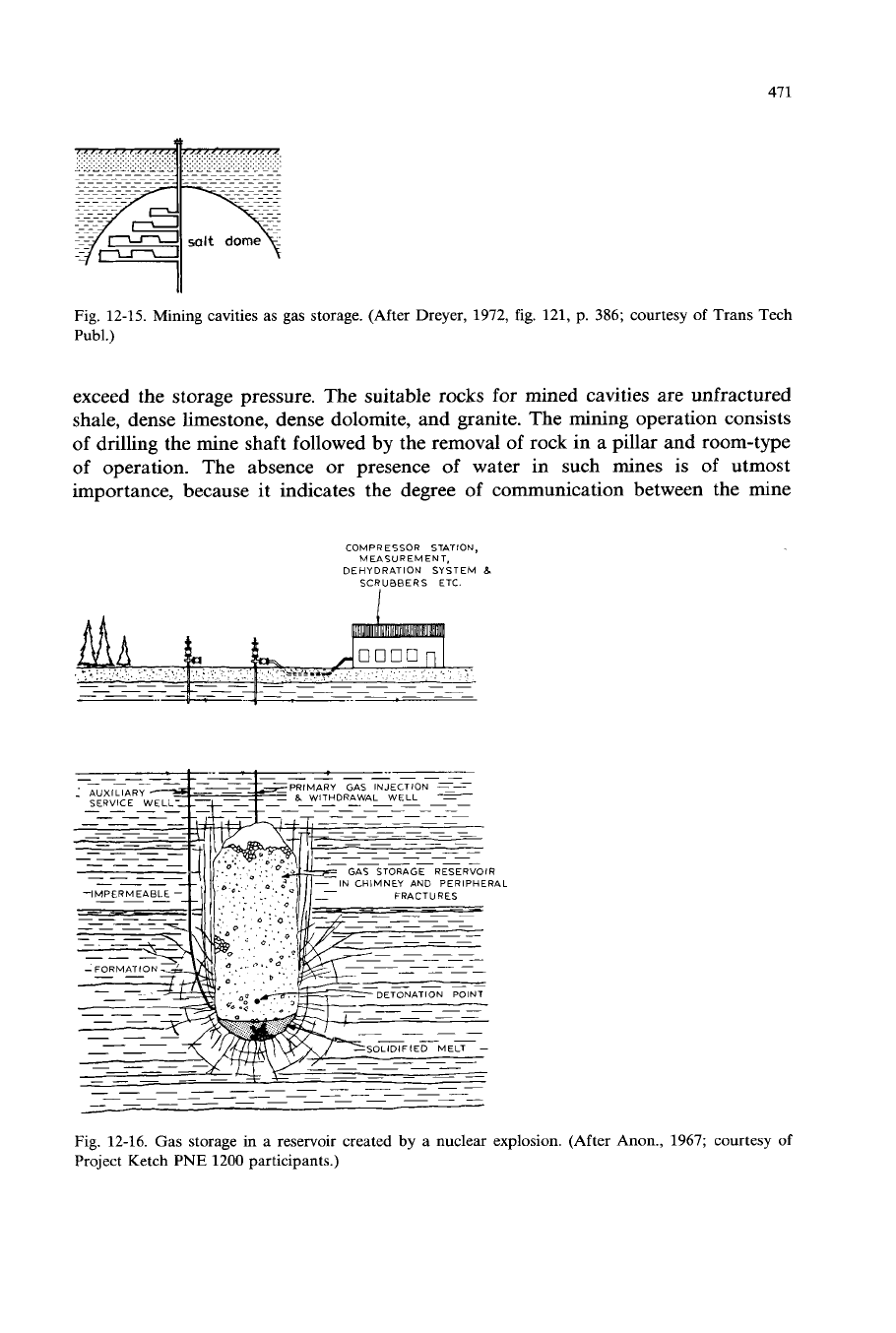
471
Fig. 12-15. Mining cavities
as
gas storage. (After Dreyer, 1972, fig. 121, p. 386; courtesy
of
Trans Tech
Publ.)
exceed the storage pressure. The suitable rocks for mined cavities are unfractured
shale, dense limestone, dense dolomite, and granite. The mining operation consists
of drilling the mine shaft followed by the removal
of
rock in a pillar and room-type
of operation. The absence or presence of water in such mines is of utmost
importance, because it indicates the degree of communication between the mine
COMPRESSOR STATION,
DEHYDRATION SYSTEM
6
MEASUREMENT,
scRuaaERs
ETC.
I
-_-----
PRIMARY GAS INJECTION
R
WITHDRAWAL WELL
-
-
-
-
-
-
-
-
-
-
- -
-
-
-
Fig.
12-16. Gas storage in a reservoir created
by
a
nuclear explosion. (After Anon., 1967; courtesy
of
Project Ketch
PNE
1200 participants.)
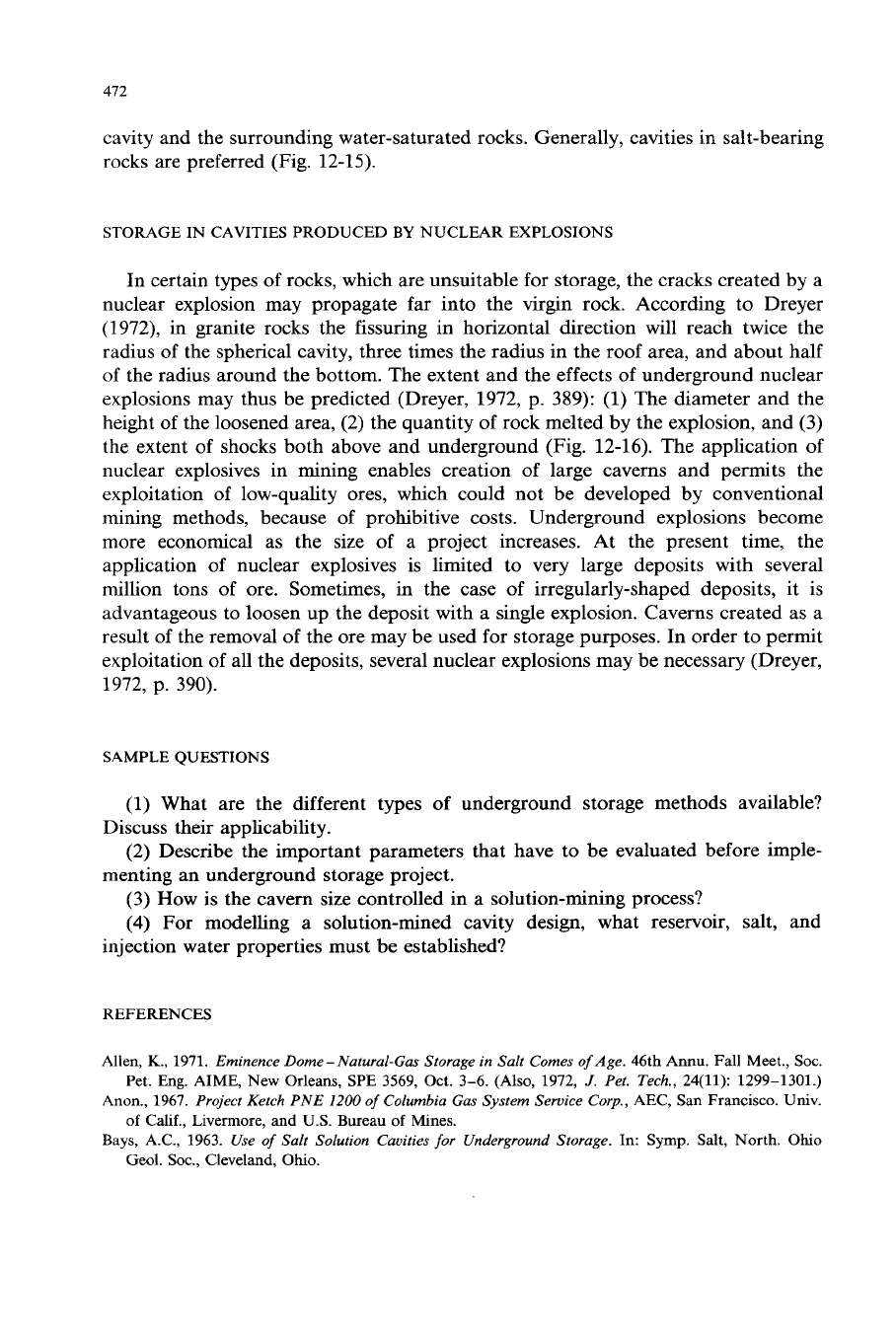
412
cavity and the surrounding water-saturated rocks. Generally, cavities in salt-bearing
rocks are preferred (Fig.
12-15).
STORAGE IN CAVITIES PRODUCED BY NUCLEAR EXPLOSIONS
In certain types of rocks, which are unsuitable for storage, the cracks created by a
nuclear explosion may propagate far into the virgin rock. According to Dreyer
(1972),
in granite rocks the fissuring in horizontal direction will reach twice the
radius of the spherical cavity, three times the radius in the roof area, and about half
of the radius around the bottom. The extent and the effects of underground nuclear
explosions may thus be predicted (Dreyer,
1972,
p.
389): (1)
The diameter and the
height of the loosened area,
(2)
the quantity of rock melted by the explosion, and
(3)
the extent
of
shocks both above and underground (Fig.
12-16).
The application of
nuclear explosives in mining enables creation
of
large caverns and permits the
exploitation of low-quality ores, which could not be developed by conventional
mining methods, because of prohibitive costs. Underground explosions become
more economical as the size of a project increases. At the present time, the
application of nuclear explosives is limited to very large deposits with several
million tons of ore. Sometimes,
in
the case
of
irregularly-shaped deposits, it is
advantageous to loosen up the deposit with a single explosion. Caverns created as a
result of the removal of the ore may be used for storage purposes. In order to permit
exploitation of all the deposits, several nuclear explosions may be necessary (Dreyer,
1972,
p.
390).
SAMPLE QUESTIONS
(1)
What are the different types
of
underground storage methods available?
(2)
Describe the important parameters that have to be evaluated before imple-
(3)
How is the cavern size controlled in a solution-mining process?
(4)
For modelling a solution-mined cavity design, what reservoir, salt, and
Discuss their applicability.
menting an underground storage project.
injection water properties must be established?
REFERENCES
Allen,
K., 1971.
Eminence Dome-Natural-Gas Storage
in
Salt Comes ofAge.
46th
Annu. Fall Meet.,
SOC.
Pet. Eng. AIME, New Orleans, SPE
3569, Oct. 3-6.
(Also,
1972,
J.
Pet. Tech.,
24(11): 1299-1301.)
Anon.,
1967.
Project Ketch
PNE
1200
of
Columbia Gas System Service
Corp., AEC, San Francisco. UNv.
of
Calif., Livermore, and U.S. Bureau of Mines.
Bays, A.C.,
1963.
Use of Salt Solution Cavities
for
Underground Storage.
In:
Symp.
Salt,
North.
Ohio
Geol.
SOC.,
Cleveland,
Ohio.
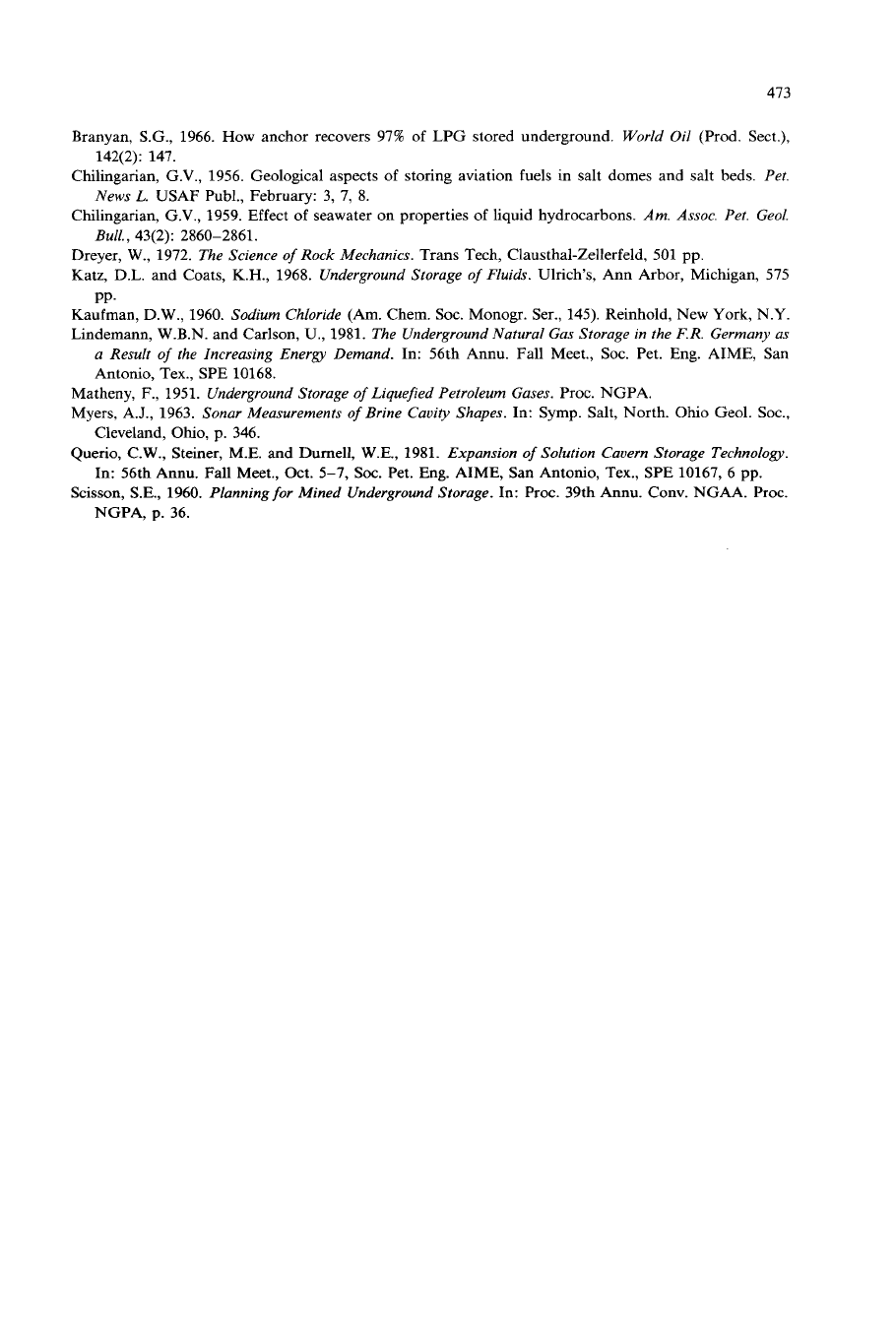
473
Branyan, S.G., 1966.
How
anchor recovers 97%
of
LPG stored underground. World Oil (Prod. Sect.),
Chilingarian, G.V., 1956. Geological aspects
of
storing aviation fuels in salt domes and salt beds. Pet.
Chilingarian,
G.V.,
1959. Effect
of
seawater on properties
of
liquid hydrocarbons.
Am.
Assoc. Pet. Geol.
Dreyer, W., 1972. The Science
of
Rock
Mechanics. Trans Tech, Clausthal-Zellerfeld, 501 pp.
Katz, D.L. and Coats,
K.H.,
1968. Underground Storage
of
Fluids. Ulrich’s, Ann Arbor, Michigan, 575
Kaufman, D.W., 1960.
Sodium Chloride (Am. Chem. SOC. Monogr. Ser., 145). Reinhold, New York, N.Y.
Lindemann, W.B.N. and Carlson, U., 1981.
The Underground Natural Gas Storage
in
the F.R. Germany as
a Result
of
the Increasing Energy Demand. In: 56th Annu. Fall Meet., SOC. Pet. Eng. AIME, San
Antonio, Tex.,
SPE
10168.
142(2): 147.
News L. USAF Pub]., February: 3, 7, 8.
Bull., 43(2): 2860-2861.
PP.
Matheny,
F.,
1951. Underground Storage
of
Liquefied Petroleum Gases. Proc. NGPA.
Myers, A.J., 1963.
Sonar Measurements
of
Brine Cavity Shapes. In: Symp. Salt, North. Ohio Geol. SOC.,
Cleveland,
Ohio,
p. 346.
Querio, C.W., Steiner, M.E. and Durnell, W.E., 1981.
Expansion of Solution Cavern Storage Technology.
In: 56th Annu. Fall Meet., Oct.
5-7,
SOC.
Pet. Eng. AIME, San Antonio,
Tex.,
SPE 10167, 6 pp.
Scisson, S.E., 1960.
Planning for Mined Underground Storage. In: Proc. 39th Annu. Conv. NGAA. Proc.
NGPA,
p.
36.

This Page Intentionally Left Blank
